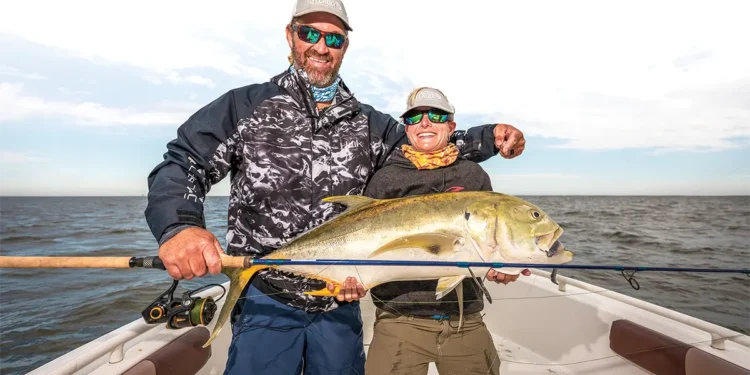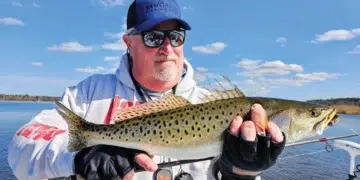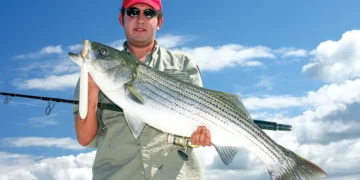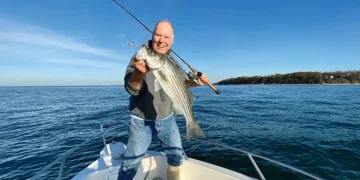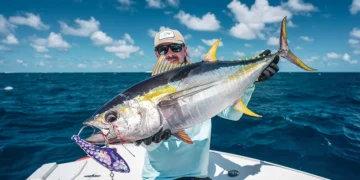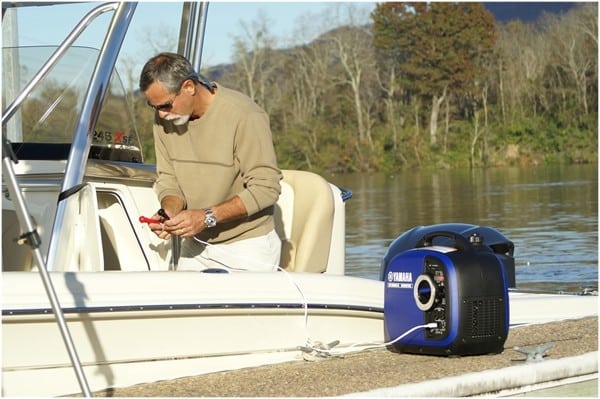For an all-out tussle, it’s hard to beat the pugnacious jack crevalle.
There’s a lot to be said for the intricacies of finesse fishing, the targeting of wary fish with light tackle, svelte lures, and highly refined presentations all aided by a stealthy approach and a secret hot spot you’d prefer to fish under the cover of a heavy fog. But, if you are anything like me on the briny, there are some days when all that fine detail simply won’t hold focus. You know what I’m talking about, those trips when you want nothing more than an all-out brawl with a wild-eyed battler that throws caution to the wind. When that’s the case, I’ve got two words to quell your craving: jack crevalle!
This is one species that definitely doesn’t get the praise it deserves. Aggressive, powerful, and willing to engage on a nearly constant basis, jack crevalle also grow quite large for an inshore species. The current International Game Fish Association (IGFA) world record is a 58-pound, 8-ounce brute caught by Nicholas Fano in October 2021. Given their size, widespread availability, and pugnacious character, they are targeted less than you might think which is, perhaps, one reason they’ll reliably stick around for a while wherever they can find some wholesome feed like mullet, ladyfish, pompano, snapper blues, croakers, crabs, or shrimp.
Also Read
Sport Express Cruiser Buyers’ Guide: 22 Standout Boats Going Into 2026
Performance and power come together in 22 versatile vessels. Quick Facts Coverage: 22 sport express cruisers across cats, CCs, jets,...
“If only they ate well or jumped, they would be the one fish everyone targets around here,” says Capt. George Gozdz, a Stuart, Florida, charter skipper and host of the popular Outdoor Channel fishing show Unfathomed (unfathomedfishing.com).“They are a great fish for introducing novice anglers to top-level saltwater competitors. Pound for pound, they’re as tough to battle as anything you’ll find on the inshore scene. We get them to forty pounds along our outside beaches. Inside our bays, the average size is probably between five and ten pounds—but trophy-sized bruisers are not uncommon.”
Gozdz points out that jack crevalle (JC) are very much like giant trevally (GT) in terms of attitude, toughness, and aggressiveness. GTs grow much larger, of course—the world record is 180 pounds—but the same qualities that cause anglers to travel the world in search of a GT experience should endear anglers to the JCs as well.
While Northeast and Mid-Atlantic anglers occasionally catch small jack crevalle mixed with snapper blues and juvenile weakfish during late summer and early fall, the range for adults in U.S. waters primarily stretches from North Carolina to the Florida Keys and Gulf Coast waters. As a rule, the farther south one heads, the greater the odds of jack encounters.
My first experiences with jack crevalle came from shallow waters in the northwest corner of Florida’s Tampa Bay some years ago, and I was not disappointed when they interrupted a casting session for redfish. I was shocked by the viciousness of the first strike early in the morning and the prolonged battle that followed. I was also thrilled to deck that fish on 12-pound-class spinning gear.
Subscribe Here For More Boating Content
It was in the waters off Costa Rica, however, when I saw for the first time the immense power of a larger jack and its ability to test the will of a seasoned angler. On that trip out of Los Sueños, my wife, Felicia Scocozza, and I were targeting roosterfish, which had been on our bucket list for some time. Felicia hooked up first that day, and following a particularly spirited battle, managed to bring aboard a large, long-finned 30-pounder that ate a live-lined lookdown only minutes away from our marina.
“That one fought REALLY hard,” she said with a laugh before slumping into a seat after our skipper released the elegantly adorned trophy back into the dark-blue waters of Herradura Bay. Ten minutes later, Felicia was ready to resume fishing. She dropped another lookdown into the water and within a minute or two was into her second powerful fish.
“I don’t know if I can hold onto this one,” she yelled out as the battle progressed. “My arms are killing me!” That was her introduction to jack crevalle. Beat from her roosterfish, that jack took every liberty it could to first take drag, then sulk deep and, finally, circle like a stubborn tuna beneath our vessel. It took every ounce of strength to bring that beast to the surface.
“That’s it, I’m done for now,” Felicia announced as she dropped back into the chair aching from the back-to-back battles. “That was a lot of work!” Her reaction was not an uncommon occurrence where large JCs are involved. Those fish know how to fight to the finish.
Also Read:
Increased Cruising Permit Fees – Bahamas’ New Rules Take Effect July 1
Updated July 31, 2025. If the Bahamas is on your cruising itinerary, pay attention: Starting July 1, 2025,...
Gozdz points out that specialized gear isn’t necessary to win out over jacks. But you do want to match it to the general size of the fish you expect to catch. To that end, for bigger jacks weighing 20 pounds or more, a spinning setup featuring a 7-foot, medium-heavy rod and a size 5500 reel filled with 30-pound test braid is about right when fishing around structure where breakoffs are a distinct possibility. From there, you can downsize to a slightly smaller spinning rod, 3000- to 4000-class reel, and 20-pound test braid for fishing in unobstructed water or targeting smaller fish.
While jack crevalle may not jump while fighting, they have no adversity to smashing lures on the surface—another excellent trait. Keep in mind, however, that they are ambush feeders, so they prefer to target bait in areas where it can be pinned against a sea wall or bulkhead, as you’ll often see them do with mullet. They’ll also chase baitfish out from under a dock or drive them from the flats into adjacent channel water with more current and a tactical advantage in maneuverability for the stronger, fast-swimming predator. In deeper open waters, they’ll frequently herd schools of baitfish into tight balls before ripping through for a meal.
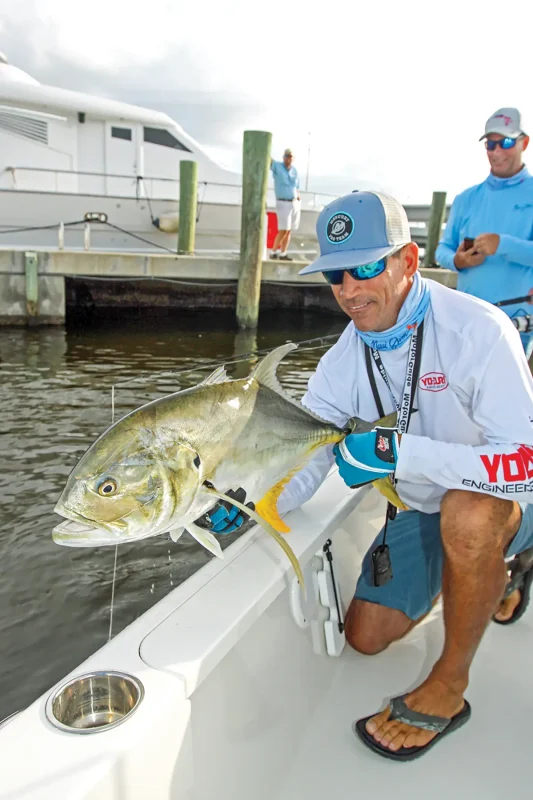
You can catch these gamesters on both cut and live baits, including mullet, pilchards, threadfin herring, and shrimp. For lures, surface poppers, jerk baits, and tins all work well. Like many anglers, Gozdz favors surface lures like Yo-Zuri Surface Cruiser pencil poppers to take advantage of exciting top-water strikes. “You really can’t go wrong in throwing big lures for these fish,” he advises. “In my area, the jacks are inside eating ten-inch mackerel. They aren’t shy.”
You shouldn’t be shy either when the JCs come to town. Catch them, release them, and revel in the simplicity of the chase for these exceptional competitors are truly worthy of admiration from anglers of every skill level. Just ask anyone who has ever hooked one immediately after battling a trophy roosterfish.
-By Tom Schlichter


